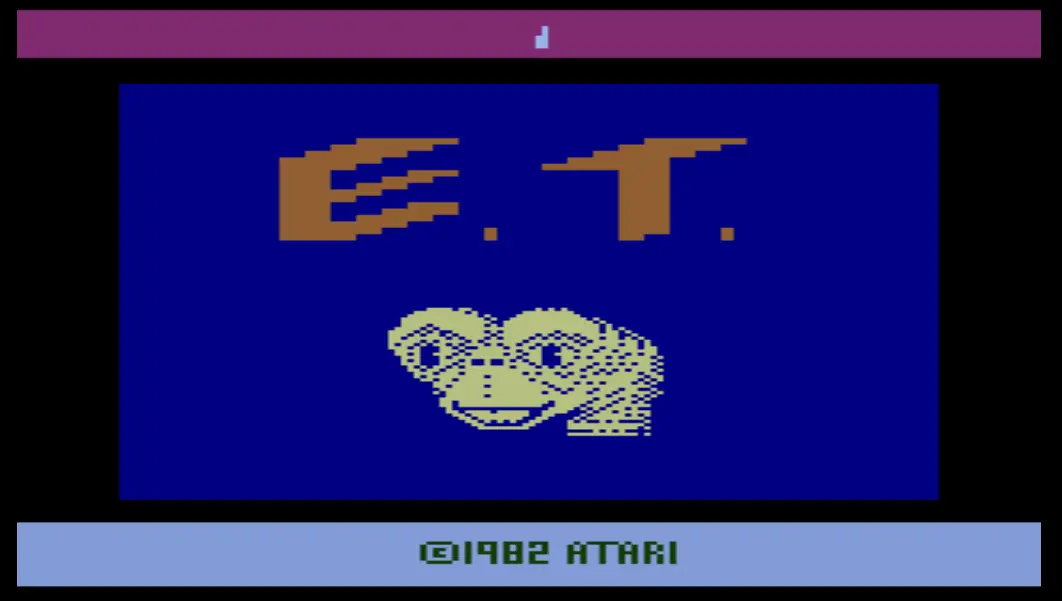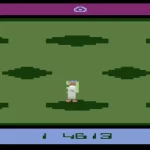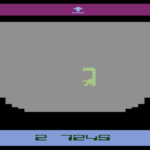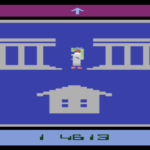Released in December 1982, E.T.: The Extra-Terrestrial is a notoriously bad game. Based on the Steven Speilberg movie of the same name, popular gaming lore blames it for the collapse of the video game industry in 1983 and claims hundreds of thousands of E.T. game cartridges were buried in a landfill.
There’s some truth to this – it was released just before the Atari-led gaming industry collapsed, but it was more a symptom than a cause. And copies of it were buried in a landfill … just not as many as people claimed.
But is it a bad game? Sadly, I have to say yes.
Quote
Beside the Atari was a shoebox containing nine game cartridges: Combat, Space Invaders, Pitfall, Kaboom!, Star Raiders, The Empire Strikes Back, Starmaster, Yars’ Revenge, and E.T. — Ready Player One p. 102
Game Play
Represents a kind of open-world game for the Atari. Like Adventure, Superman, and the various SwordQuest games (Earthworld, Fireworld, Waterworld), it didn’t have a set path for players to follow. In all of these, exploration was key – instead of sending your avatar speeding through a maze consuming power pellets, you need to think through how to best navigate the world, solve its puzzles, and complete its goals.
In E.T., the goal is to guide its signature alien through six sites to find the three missing pieces of his telephone. Once assembled, he uses it to call home, summon his friends, and escape Earth. He needs to accomplish this before running out of energy, or the game is over.
The different sites are divided up into different zones, each of which allows E.T. to use one (and only one) of his special powers (e.g. levitate, call his human friend Elliot for help, call the alien ship, etc.). This critical bit of information is conveyed via the instruction manual and without it, the game doesn’t make a ton of sense.
Along the way, E.T. can collect candy pieces, which let him summon Elliot for assistance as well as earn bonus points at the end of the game.
Impressions
Beware of Pits
Talk with someone about the E.T. video game and they’ll probably say something about the pits (aka “wells”).
And your inability to avoid them.
And constantly falling into them.
And then dying because the game glitched, and you couldn’t escape them.
Now the movie, as I recall, doesn’t have a lot of gaping holes in the Earth. Annoying kid sisters? Yep. An awesome game of Dungeons & Dragons? Yep. A mass frog liberation? Yep. Flying bicycles? Yep.
But wells? No, I don’t recall any wells. But for reasons known only to Howard Scott Warshaw (who wrote the far superior Yars’ Revenge, which was released several months before E.T. in May 1982), the video game is filled with them. Outside of the forest, the digital countryside is littered with wells, and you have to deal with them. Pieces of E.T.’s lost phone lie at the bottom of them, so you’re going to have to enter a few to recover them.
Scattered in between the pit openings are bits of candy, which is in keeping with the movie … but they also seem like a cruel trick to lure you back to the wells. The other notable location in the game is the Washington, D.C. screen, where we find Elliot’s house, FBI headquarters, and a science building. Throughout the game, scientists and FBI guys are continuously chasing you, and when they catch you, they bring you back to their respective buildings.
Unless, of course, you evade them by falling down a well.
[sigh]
A Bad Game That Doesn’t Improve With Time
Taken at face value, the game’s just plain bad. Not because of the low-end graphics (this is, after all, the Atari 2600 we’re talking about). Visually, they did the best they could with what they had. But gameplay-wise, the game is frustratingly, boringly repetitive. Even after reading the manual, even after knowing what the various symbols did, I don’t a little better than my earlier, more ignorant self.
The game doesn’t reward you for investing the time to get better at it, and there’s no compelling hook to pull you on.
At least, I thought there wasn’t.
It turns out that, as he did in Yars’ Revenge and Indiana Jones, Howard Scott Warshaw included Easter Eggs in this game:
- A miniature Yar,
- A tiny Indiana Jones,
- The author’s initials.
That’s the sort of thing that – had I known about it as a kid – would have kept me playing. And it’s very much in keeping with the “Easter Egg” setup of Ready Player One (so much so that you would have thought that HSW would have gotten a mention in the book since his Easter Eggs are actually more interesting than the original one featured in Adventure.
I never hunted down these Easter Eggs, though I was tempted. It’s enough for me to know that they exist.
The Ready Player One Replay is an ongoing exploration of the games that inspired the novel Ready Player One by Ernest Cline. Love it or hate it, there’s value in revisiting our geeky roots.
High Scores
- My High Score: I died. A lot.
E.T. Resources
Where to Play
Commentary
- Video Game History Foundation: Review Roundup – Was E.T. Really the Worst Game Ever?
- 8-Bit Central: Atari E.T. The Extra-Terrestrial
- Inverse: The Worst Video Game of All Time Got One Thing Hilariously Right
- Kikoskia: Let’s Play E.T: The Extra-Terrestrial (video)
- Lord Kayoss: E.T. Documentary & Complete Playthrough | Worst Video Game Atari (video)
- Digital Press: Interview with Howard Scott Warshaw
- Giant Bomb: E.T.: The Extra-Terrestrial – an excellent overview and guide to the game, with an explanation of its various symbols and gameplay.









